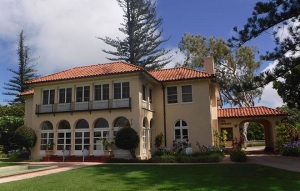PRESERVATION IN THE NEWS: Magical Hui Noeau Visual Arts Center offers guided walking tours of the 25 acre historic Kaluanui Estate rife with history, botanical gardens and art studios.
Maui estate celebrates visual arts and history
Honolulu Star Advertiser August 2, 2015

COURTESY MIEKO PHOTOGRAPHY Artist Stephen Fellerman instructs students in a glass-blowing class. Classes are held in the studios, and artists often can be found working there. Visitors, both on the guided and self-guided tours, are welcome to take a quick peek at what’s going on in the studios.
Art and history go hand in hand on these 25 Upcountry acres overlooking the West Maui Mountains and the verdant north shore. East Maui Plantation opened on the site in 1850. When it closed in 1885, entrepreneur Henry Baldwin bought the property.
Three decades later his son and daughter-in-law, Harry and Ethel Baldwin, retained famed architect C.W. Dickey to design a home for them there. The elegant two-story mansion was completed in 1917; its name, Kaluanui, means “big pit,” referring to nearby Maliko Gulch.

HUI NOEAU VISUAL ARTS CENTER Built in 1917, Kaluanui, Harry and Ethel Baldwin’s estate, is now the home of Hui Noeau Visual Arts Center. Ethel Baldwin founded the hui in 1934.
Ethel and her daughter, Frances Baldwin Cameron, were patrons of the arts, and in 1934 they formed Hui Noeau (“coming together for the development of artistic skill”), a group of 20 women who initially met at Kaluanui to pursue their shared passion for drawing, painting and ceramics.
Today the estate is the permanent home of Hui Noeau, which has grown into a nonprofit community-based organization offering a full slate of activities, classes and events celebrating the visual arts.
Several years ago the hui launched an “on-demand” guided tour in response to public interest in the history of Kaluanui, its expansive botanical gardens and its art studios, some of which were originally the garage, stables and dairy. The hui recently began offering the tour on a regular twice-weekly schedule.
IF YOU GO…
|
Participants see the remains of East Maui Plantation’s mill; learn about many of the 70-plus species of plants and trees that flourish on the well-manicured grounds, including a 125-foot-tall Norfolk pine believed to be more than 150 years old; and browse in the History Room, formerly Harry Baldwin’s office, where a saddle, spurs, a copper pot for salting meat and other paniolo (cowboy) artifacts recall the history of Haleakala Ranch. Harry was the ranch’s president from 1911 to 1946.
Highlights also include the studios, usually abuzz with activity. “Hui Noeau is an open campus,” said Lana Coryell, program and exhibitions manager. “Students and professional artists often work in the studios with the doors open and invite guests to take a look at what they’re doing. Tour groups are in for a treat if artist-in-residence Evan Schauss or teaching artist Stephen Fellerman are doing glass-blowing demonstrations. They’ll see an amazing work of art being created right before their eyes.”
Another interesting stop is the Visiting Artist’s Cottage, which was Ethel Baldwin’s metal-working studio in the late 1940s. It now houses guest artists who are teaching classes.
The tour winds up at the Gallery Shop, a treasure trove of handcrafted wares, many of which have been created on-site by local artists participating in the Open Studio program.
“Visitors can stroll around on their own, but the guided tour enriches their experience,” Coryell said. “They can ask the guide questions and focus on what interests them, whether it be history, architecture, botany, visual arts or something else. On the tour they also meet members of our staff, who are all Maui residents and either artists or avid supporters of the arts and visual arts education.”
Coryell’s connection with the hui dates to the early 1990s when she was a child taking classes there. “I loved the ceramics classes because I could get messy and create all sorts of little animal figures,” she said. “I also remember a class where I created colorful drawings of red-and-blue macaws — a bird that fascinated me. My teachers supported and encouraged me to think outside the box, to tell stories with my artwork and to explore my personal interests.”
Her job enables her to continue that tradition of offering memorable and meaningful opportunities for people to engage in the visual arts.
“It’s so rewarding when students tell me how a class helped them through a difficult time or how learning a new skill gave them a new level of self-confidence,” Coryell said. “Art can be a powerful and transformative force in a person’s life. The hui is a catalyst for that, offering a beautiful, welcoming space for everyone to come, learn, enjoy and be inspired.”
Cheryl Chee Tsutsumi is a Honolulu-based freelance writer whose travel features for the Star-Advertiser have won several Society of American Travel Writers awards.

